Orateur
Summary
Development of the adaptive optics testbed LOOPS for Fourier-based wavefront sensors demonstration and analysis.
Astrophysical observations from earth-based telescopes are affected by the atmosphere turbulences. The angular resolution of these instruments is therefore highly reduced. Adaptive Optics (AO) allows, by estimating the wavrefront deformations thanks to a WaveFront Sensor (WFS) and correcting it with one or more Deformable Mirror(s) (DM), to restore the optical performances.
From the beginning of the 90s and until recently, the AO dispositives have been using Shack-Hartman WFS. New WFS based on optical Fourier filtering (such as the Zernike or pyramid WFS) are now starting to being used while still under study and development. A mathematical formalism of these kind of WFS has been proposed and deeply formalized in O. Fauvarque's thesis, opening the path toward a better formal comprehension of their operation (especially in terms of sensitivity and linearity) and therefor a way to develop new WFS.
The transposition of this theoretical work into real-life implementation and testing will be done at Laboratoire d'Astrophysique de Marseille (LAM) on the pre-existing AO bench entitled LOOPS (standing for LAM-ONERA On-sky Pyramid Sensor). For now on, the bench can operate in closed-loop conditions using a 4-sides glass pyramid, a turbulence simulator and a Boston DM (12x12 actuators). Actually under upgrade, the bench is receiving a Spatial Light Modulator (SLM) in order to produce all flavours of WFS. The SLM is a high-resolution LCD display (~1k x 1k pixels) capable of producing arbitrary phase screen that will modify the wavefront. This versatile instrument allows, for example, the creation of pyramids with variable number of faces (see Fig. 1) as well as adjustable faces angles (see Fig. 2), opening the way to innovative and hopefully more powerful WFS designs. Sensitivity and linearity measurements of new WFSs (inspired from the pyramid WFS) will be presented and compared to the results obtained in simulations. The complete setup of the LOOPS bench will also be given to provide an exact overview of the on-going the community.

Fig. 1 - Measured phase on pyramids created with a SLM for different number of faces (from left to right : 3, 4, 5 faces and an axicon).

Fig. 2 - Pyramid WFS images obtained with a SLM for a classical pyramid (left) and a flattened pyramid (right).
